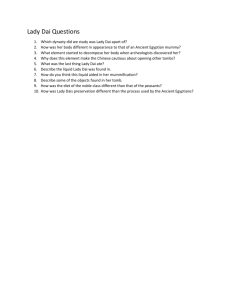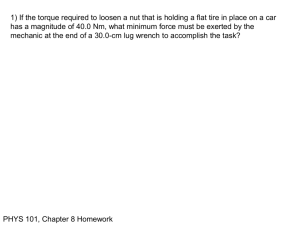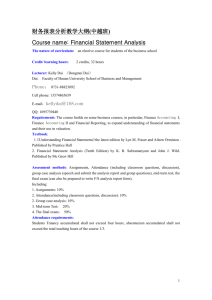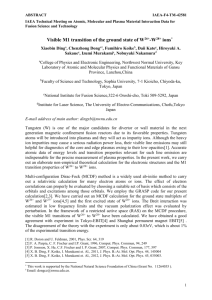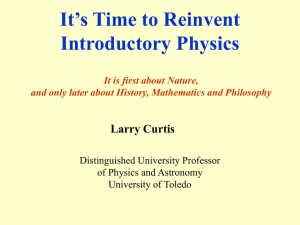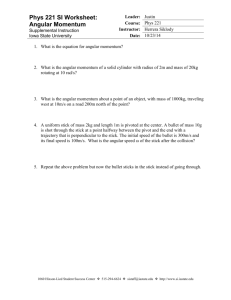PHYS 342/555 Introduction to solid state physics
advertisement
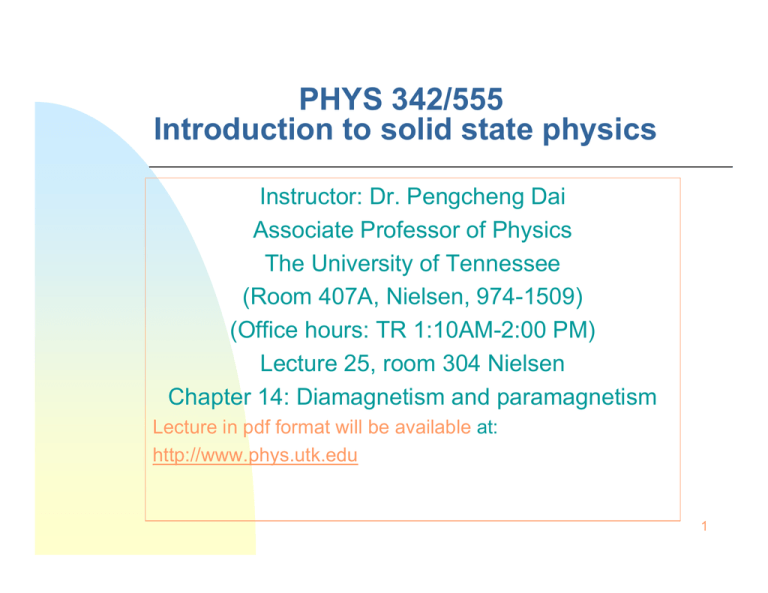
PHYS 342/555 Introduction to solid state physics Instructor: Dr. Pengcheng Dai Associate Professor of Physics The University of Tennessee (Room 407A, Nielsen, 974-1509) (Office hours: TR 1:10AM-2:00 PM) Lecture 25, room 304 Nielsen Chapter 14: Diamagnetism and paramagnetism Lecture in pdf format will be available at: http://www.phys.utk.edu 1 Consider a system of two neutral atoms separated by a fixed distance a, each atom having a polarizability α . Find the relation between a and α for such a system to be ferroelectric. Dai/PHYS 342/555 Spring 2006 Chapter 14-2 Chapter 14: Magnetization density and susceptibility The magnetization M is defined as the magnetic moment per unit volume. The magnetic susceptibility per unit volume is defined as χ = M / B, where B is the macroscopic magnetic field intensity. χ is the susceptibility. Substances with a negative magnetic susceptibility are called diamagnetic. Substances with a positive susceptibility are called paramagnetic. Dai/PHYS 342/555 Spring 2006 Chapter 14-3 Langevin diamagnetism equation The diamagnetic susceptibility per unit volume is, NZe 2 2 χ =− r ; 2 6mc where N is the number of atoms per unit volume, r 2 is the mean square distance of the electrons from the nucleus, Z is number of electrons in each nuclei. Dai/PHYS 342/555 Spring 2006 Chapter 14-4 Paramagnetism Electronic paramagnetism: 1. Atoms, molecules, and lattice defects possessing an odd number of electrons. 2. Free atoms and ions with a partly filled inner shell: transition elements; ions isoelectronic with transition elements; rare earth and actinide elements. 3. A few compounds with an even number of electrons, including molecular oxygen and organic biradicals. 4. Metals. Dai/PHYS 342/555 Spring 2006 Chapter 14-5 Quantum theory of paramagnetism The magnetic moment of an atom or ion in free space is given by G G G μ = γ =J = − g μ B J , G where the total angular momentum =J is the sum of the orbital G G =L and spin =S angular momenta. γ is the gyromagnetic ratio. g μ B ≡ −γ =. For an electron spin g = 2.0023. For a free atom J ( J + 1) + S ( S + 1) − L( L + 1) g = 1+ 2 J ( J + 1) The Bohr magneton μ B is defined as e= / 2mc. Dai/PHYS 342/555 Spring 2006 Chapter 14-6 The energy levels of the system in a magnetic field are G G U = − μ ⋅ B = mJ g μ B B , where mJ is the azimuthal quantum number and has the values J , J − 1,..., − J . For a single spin with no orbital moment we have mJ = ±1/ 2 and g = 2, U = ± μ B B. Dai/PHYS 342/555 Spring 2006 Chapter 14-7 If a system has only two levels the equilibrium populations are, with τ ≡ k BT N1 exp( μ B / τ ) = ; N exp( μ B / τ ) + exp(− μ B / τ ) N2 exp(− μ B / τ ) = N exp( μ B / τ ) + exp(− μ B / τ ) Here N1 , N 2 are the populations of the lower and upper levels. N = N1 + N 2 is the total number of atoms. Dai/PHYS 342/555 Spring 2006 Chapter 14-8 The projection of the total magnetization for N atoms per unit volume is, with x ≡ μ B / k BT , e x − e− x M = ( N1 − N 2 ) μ = N μ x − x = N μ tanh x. e +e Here x 1, tanh x ≅ x, and we have M ≅ N μ ( μ B / k BT ) . Dai/PHYS 342/555 Spring 2006 Chapter 14-9 Hund’s rules Suppose we have a free atom or ion in which all electronic shells are filled or empty except for one, whose one-electron levels are characterized by orbital angular momentum l. Since for given l there are 2l + 1 values lz can have (l , l − 1, l − 2,..., −l ) and two possible spin directions for each lz , such a shell will contain 2(2l + 1) one-electron levels. Let n be the number of electrons in the shell, with 0 < n < 2(2l + 1). If the electrons did not interact with one another, the ionic ground state would be degenerate, reflecting the large number of ways of putting n electrons into more than n levels. However, this degeneracy is considerably lifted by electron-electron Coulomb interactions as well as by the electron spin-orbit interaction. Dai/PHYS 342/555 Spring 2006 Chapter 14-10 1. Russel-Saunder coupling To a good approximation the Hamiltonian of the atom or ion can be taken to commute with the total electronic G G spin and orbital angular momenta, S and L, as well as with the total G G G electronic angular momentum J = L+S. 2. Hund's first rule Out of the many states one can form by placing n electrons into the 2(2l + 1) levels of partially filled shells, those that lie lowest in energy have the largest total spin S that is consistent with the exclusion principle. 3. Hund's second rule The total orbital angular momentum L of the lowest-lying states has the largest value that is consistent with Hund's first rule, and with the exclusion principle. Dai/PHYS 342/555 Spring 2006 Chapter 14-11 4. Hund's third rule The first two rules determine the values of L and S assumed by the states of lowest energy. This still leaves (2 L + 1)(2 S + 1) possible states. These can be further classified according to their total angular momentum J , which, according to the basic rules of angular momentum composition, can take on all integral values between L − S and L + S . The degeneracy of the set of (2 L + 1)(2S + 1) states is lifted by the spin-orbit coupling, which, within this set of states, can be represented by a term in the Hamiltonian of the simple form G G λ (L ⋅ S). Spin-orbit coupling will favor maximum J if λ is negative, and minimum J if λ is positive. λ is positive for shells that are less than half filled and negative for shells that are more than half filled. J = L − S , n ≤ (2l + 1), J = L + S , n ≥ (2l + 1). Dai/PHYS 342/555 Spring 2006 Chapter 14-12 The orbital angular momentum L is given by a letter, L = 0123456 X = SPDFGHI Dai/PHYS 342/555 Spring 2006 Chapter 14-13 Curie’s law in solids Insulating crystals containing rare earth ions are found to obey Curie's law. One frequently writes the law in: 1 N μ B2 p 2 , χ= 3 V k BT where p is the "effective Bohr magneton number", p = g ( JLS )[ J ( J + 1)]1/ 2 . In all cases the magnetism of rare earth ions in an insulating solid is well described by treating them as isolated ions. For transition metal ions from the iron group, one finds that although Curie's law is obeyed, the value of p is still given by above equation only if one assumes that although S is given by Hund's rules, L is zero and J=S. This is known as the quenching of the orbital angular momentum. Dai/PHYS 342/555 Spring 2006 Chapter 14-14 Dai/PHYS 342/555 Spring 2006 Chapter 14-15 Dai/PHYS 342/555 Spring 2006 Chapter 14-16 Crystal field splitting Crystal field splitting is unimportant for rare earth ions, because their partially filled 4 f shells lie deep inside the ion. In contrast to this, the partially filled d -shells of transition metal ions are the outermost electronic shells, and are therefore far more strongly influenced by their crystalline environment. The interaction of the paramagnetic ions with the crystal field has two major effects: the coupling of L and S vectors is largely broken up, so that the states are no longer specified by their J values; the 2L+1 sublevels belonging to a given L which are degenerate in the free ion may now be split by the crystal field. Dai/PHYS 342/555 Spring 2006 Chapter 14-17 Dai/PHYS 342/555 Spring 2006 Chapter 14-18 Consider a two-level system with an energy splitting k B Δ between upper and lower states; the splitting may arise from a magnetic field or in other ways. Show that the heat capacity per system is: Δ /T Δ / T e ( ) 2 ⎛ ∂U ⎞ . C =⎜ ⎟ = kB 2 Δ /T ⎝ ∂T ⎠ Δ 1 e + ( ) Peaks of this type in the heat capacity are often known as Schottky anomalies. Dai/PHYS 342/555 Spring 2006 Chapter 14-19
